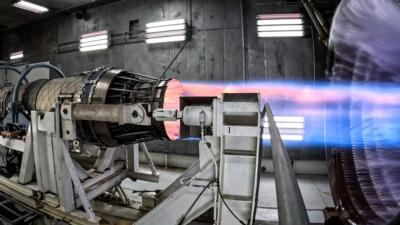Tue, May 21, 2024
Eagle Engine Proves to Be a Capable Partner for Hypersonic Ambitions
Hypersonic startup Hermeus provided an update on their engine testing, describing some of the progress made on their F100 engine installation.

The big deal lately has been integrating the Pratt & Whitney F100 into their 'Quarterhorse Mk 2', and understandably daunting issue given the excessive heat generated by pretty much every aspect of supersonic flight. Lately they've focused on cooling, developing a pre cooler to increase the max output of the F100 by chilling its pre-intake air. They apparently have seen some success, with their new system proving useful under a variety of loads. Still, much remains to be done, since they need to move onto hotter intake air and rougher thermal conditions.
The F100 will be the beating - or better said, whirring - heart of the Quarterhorse, drawing upon decades of design know-how gleaned from the engine's long life in the F-15 Eagle program. In Hermeus' installation, the engine will be part of the Chimera, a turbine-based combined cycle engine. IN lower speed regimes, the Chimera will operate in turbine mode with the F100, transitioning to a ramjet mode as it increases speed. Hermeus intends for the pre cooler setup to help mitigate a rough transition between the two modes of operations by increasing the F100's performance right up to ramjet speeds.

It's a problem seen in automotive and motorcycle design for years now, a frequent headache for tuners as they find their project 'stumbles' as it moves between one lower-output power phase to a higher-output one. But, it seems like Hermeus believes they're close to success, ensuring the Chimera powers right through Mach 2.5, and all the way up to Mach 4 in its current thought.
"Airbreathing engines are critical to Hermeus' goal of operationalizing hypersonic aircraft," said Hermeus Co-Founder and Chief Technologist, Glenn Case. "By making a full-range, air-breathing hypersonic engine, Hermeus is setting the stage for aircraft that are capable of taking off from a regular runway and accelerating up to hypersonic speeds. No rockets or motherships required."
More News
Convective SIGMET A weather advisory concerning convective weather significant to the safety of all aircraft. Convective SIGMETs are issued for tornadoes, lines of thunderstorms, e>[...]
Aero Linx: United Flying Octogenarians WELCOME to a most extraordinary group of aviators, the United Flying Octogenarians (UFO). Founded in 1982 with just a handful of pilots, we h>[...]
Pilot’s Decision To Attempt Takeoff With Frost Covering The Airplane’s Wings Analysis: The pilot of the light sport airplane was preparing to depart for a cross-country>[...]
“We’ve paid for the cable line’s repair for the customer and have apologized for the inconvenience this caused them...” Source: Some followup info from an A>[...]
Coupled Approach An instrument approach performed by the aircraft autopilot, and/or visually depicted on the flight director, which is receiving position information and/or steerin>[...]
 ANN's Daily Aero-Term (12.01.25): Convective SIGMET
ANN's Daily Aero-Term (12.01.25): Convective SIGMET ANN's Daily Aero-Linx (12.01.25)
ANN's Daily Aero-Linx (12.01.25) NTSB Final Report: Remos Aircraft GmbH Remos GX
NTSB Final Report: Remos Aircraft GmbH Remos GX Aero-News: Quote of the Day (12.02.25)
Aero-News: Quote of the Day (12.02.25) ANN's Daily Aero-Term (12.02.25): Coupled Approach
ANN's Daily Aero-Term (12.02.25): Coupled Approach



